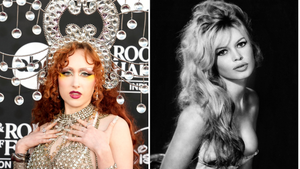Jennie Wood's new young adult graphic novel, Flutter, Volume One: Hell Can Wait -- dedicated to anyone who has ever felt uncomfortable in their own skin -- utilizes a supernatural protagonist to explore transgender and queer experiences. As the book opens, Lily, a teenage girl, is coming to grips with some unusual capabilities, including super strength and atheism, the ability to heal instantly and the potential to shape shift. With her supernatural abilities, Lily is in some ways like a classic comic superhero, but this is hardly a traditional superhero story.
And for all her abilities, Lily is just a normal teenager trying to find her place in the world.
At first, her difference is a burden and the source of discomfort and pain. For example, the fact that she doesn't get sick or hurt like other kids makes her feel like a freakish outsider when all she wants to do is fit in and be like everyone else. Many high school students -- especially those who are LGBT-identified -- can relate to that sense of alienation and isolation.
When she develops a crush on Saffron and literally transforms into the other girl's dream boy, Lily (now Jesse) mirrors every lovelorn fool who has tried to alter themselves to become what someone else is looking for.
Naturally, the morale of the story is that Lily cannot be someone she isn't and that real love can only develop when both partners see (and are compatible with) the other's true self. In the end, Jesse has to admit, "The boy of your dreams who I've been trying so hard to be, he's not real."
In Flutter ($14.99, 215 Ink), Wood examines gender by showing us how Lily and Jesse are treated differently, even though they are essentially the same person. And she exposes cultural double standards which demand that similar behavior engender different responses depending on whether it originates from boys or girls. Especially when the behavior in question is sexual in nature.
One particularly effective scene plays out over just four panels and occurs after Jesse is (falsely) revealed to have slept with another girl, Penelope. In the first two panels, Jesse is shown in a school hallway basking in the attention of fellow students, who are all smiling. "Hey Stud," one boy greets the basketball star. "Hope you're saving some of it for the playoffs."
The following two panels show the exact same scene, but now Penelope stands amid sneering students, her head bowed. The same boy who applauded Jesse greets Penelope by leering, "What are you doing right now? Wanna go for two this time?"
While a sexual boy is heralded as a conquering hero, the girl in the relationship often faces slut-shaming, ostracization, and threats of sexual violence, as though once she allows one man sexual access, she is "asking for it" from any future takers, whether she consciously acquiesces or not.
![Fluttercoverx400d[1 ]](data:image/svg+xml,%3Csvg%20xmlns='http://www.w3.org/2000/svg'%20viewBox='0%200%20400%20607'%3E%3C/svg%3E) This powerful scenario also demonstrates the strength of artist Jeff McComsey's illustrations. After all, throughout the 110 pages of Flutter, Wood often forgoes the use of narration and relies entirely on a perfect potpourri of dialogue and imagery to convey emotion and story.
This powerful scenario also demonstrates the strength of artist Jeff McComsey's illustrations. After all, throughout the 110 pages of Flutter, Wood often forgoes the use of narration and relies entirely on a perfect potpourri of dialogue and imagery to convey emotion and story.
McComsey's art flawlessly mirrors the tone of the novel, melding the right amount of fantasy and realism. Although the book is in full color, McComsey employs monochromatic panels -- some of which have a vaguely sepia-tone quality -- to establish mood. He subtly employs artistic choices to convey meaning; for example, by depicting his adult characters with sharper lines and shadows that suggest secret -- and often sinister -- agendas.
While Lily/Jesse is Flutter's central protagonist, Penelope gains more importance as the story unfolds. In Penelope, we are introduced to a teenage girl who is dealing with the death of her mother, the abuse of a violent stepfather, and the nature of her own sexuality.
"I wanted to be straight just so those assholes at school would be wrong," Penelope acknowledges at one point, echoing hundreds of gay, bisexual, and lesbian kids who've been subjected to homophobic taunting. "I hated that they seemed to know something about me before I did."
As a story about coming of age and accepting one's true self, Flutter would be compelling enough, but woven through the graphic novel are many layers, providing additional depth to a twisted tale that involves transgenic medical experimentation, environmental pollution, international spies, kidnapping, assassination, and government conspiracies.
Superhero comics often present one-dimensional characters pitched in battles between good and evil, but Flutter is populated by realistically complex people. The bad guys love their kids. Lily's father may be secretly using her, even if he's doing so for altruistic purposes. A governor who opposes marriage equality is disturbed when a supporter suggests a more permanent solution for LGBT people. "I'm not interested in encouraging hate," she exclaims, as though honestly oblivious to the potential her campaign rhetoric has to incite violence. A bit like real life.
In all, Flutter is one of the year's best LGBT graphic novels. It's an engaging and complex queer teen love story and character driven adventure that will set your heart aflutter and leave you waiting impatiently for Flutter, Volume Two.


![Fluttercoverx400d[1 ]](https://www.advocate.com/media-library/fluttercoverx400d-1.jpg?id=32759858&width=980) This powerful scenario also demonstrates the strength of artist Jeff McComsey's illustrations. After all, throughout the 110 pages of Flutter, Wood often forgoes the use of narration and relies entirely on a perfect potpourri of dialogue and imagery to convey emotion and story.
This powerful scenario also demonstrates the strength of artist Jeff McComsey's illustrations. After all, throughout the 110 pages of Flutter, Wood often forgoes the use of narration and relies entirely on a perfect potpourri of dialogue and imagery to convey emotion and story.

































































Charlie Kirk DID say stoning gay people was the 'perfect law' — and these other heinous quotes